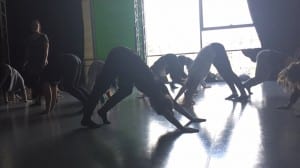Week Two: 03/02
Observing the class is a different experience to actually participating. There were a lot smaller details of the class that I actually understood and saw the results in the other bodies in the room, which when I’ve previously took part, it didn’t appear as external or visible. It was helpful for me to see the different movement in the room and almost observe the types of things that I can maybe recognise for myself and my own performance. I was able to observe the different reactions to the method in the room and how the bodies that are normally around me, react to the prompting that I also receive and how different we all are as a collective.
The first thing I noticed when they started the class was the energy in the room as everyone was lay on the floor, eyes closed and tuning into their bodies. It was clear to me whilst watching, that the use of breath from everyone in the room was what provided this energy and created a relaxed mood in the studio that everyone could enjoy.
When everyone was directed to start moving in the space and were given different stretches to move between. These were: Downward Dog (with padding through the feet, for an active stretch through the hamstrings and the calves), child’s pose and table top, which like many of the exercises in the previous week, were adaptable in order to adjust to each individual and ensure that they’re stretching for their own bodies.
The next experimental exercise was a mutual exploration of the body in pairs, which included very slow paced gestural movements from each pairing in the studio. It was clear when watching some of the pairings that their synchronicity suggests no definite leader and most, if not all pairs, executed very slow gestural movements that were only made interesting and effective by the use of mirror image. They were directed to look over the shoulder of their partner, therefore needing to use their peripheral vision in order to not copy exactly but figure the basic movement aspect of their partner’s movement. Another thing I noticed from this method, was that the movement became very limited and there was very little imagination in the way the individual moved, presumably because they were sat cross legged on the floor and the movement was only limited to the top half of their body. Personally, I found this very interesting as the dancers appeared to be moving very much in their comfort zones and not really experimenting with direction, levels or pace in this method. Whereas in their solo positions, they worked quite freely and were moving in a way that they thought could be a different way in which they normally move. I also noticed, that when the dancers were directed to increase the speed and create more variations in their movement, most pairings increased speed which resulted in the exercise becoming less of a mutual decision and more of a follow and lead. This method then progressed to a different level and the dancers were directed to try the same exercise but whilst standing, this was very surprising to me as the dancers were repeating a lot of the same exercises that they did whilst they were sat down, despite the range of movement that was now available to them.
“Tracking is a product of consciousness and unconsciousness awareness in the moment.” (Spain, 2014). From observing the class, I noticed that there was a lot of repetition in the method, even though the dancers were thinking about their movement before they executed them. Although I noticed that the dancers were looking around and had inspiration from the other people in the room, I was able to recognise a lot of habitual movement from each of the dancers. I was able to note that there was a connection between the use of internally originated movement and habitual movement, as there was clear identification of the way the dancers originated movement internally and externally. When they would internally create movement, it was less habitual and more free.
It was also easy to identify when the movement was improvised and when it was habitual, simply by the free flow and the thought time before their movement. As well as detecting the dancers who were enjoying this tool and the dancers who seemed to struggle with pre-empting their movement “Part of it is safety. Part of it, more and more is a real deep appreciation for the intelligence of that medium” (Spain, 2014).
Despite the fact that there was still a lot of anticipation within the group in regards to using improvisation, I think that the dancers are become a lot more involved and open minded to the use of improvisation and accepting the different tools that are being offered through our tutor. I am beginning to recognise that there is a lot more to improvisation than being told to just ‘do it’ as I am able to see that dancers often refer back to the material that they already know and there is nothing ‘new’ about that kind of method. By trying these different tools, we are able to open our minds to a lot more of the movement that we didn’t even know was available to us or that our bodies could do.
Bibliography
Spain, K. D., 2014. Landscape of the Now. Oxford: Oxford University Press.
